Financial Accounting: Analysis of Intangible Assets - ACC701, KOI T119
VerifiedAdded on 2023/03/23
|8
|2871
|95
Report
AI Summary
This report analyzes the accounting treatment of intangible assets and related expenses for Technology Enterprise Limited, focusing on AASB 138/ISA 38 compliance. It discusses the standard's impact on financial statement comparability and provides a detailed understanding of its requirements. The report covers the recognition and measurement of intangible assets, the treatment of R&D expenses, and the implications for companies listed on the ASX. It also highlights how differences in valuation and recognition methods can affect the comparability of financial information across firms. The report concludes with recommendations for Technology Enterprise Limited to enhance transparency and reduce investor concerns regarding intangible asset valuations.
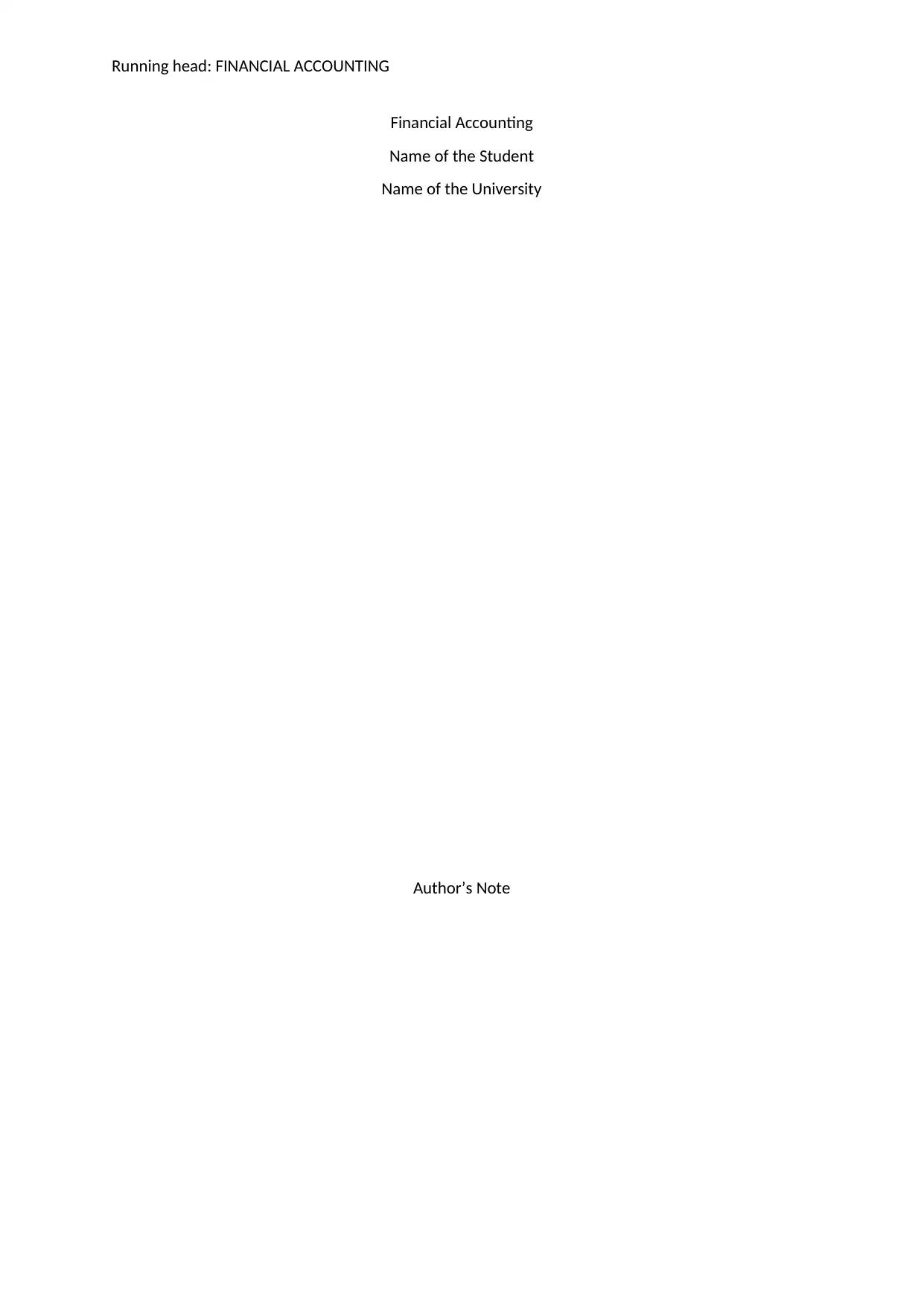
Running head: FINANCIAL ACCOUNTING
Financial Accounting
Name of the Student
Name of the University
Author’s Note
Financial Accounting
Name of the Student
Name of the University
Author’s Note
Paraphrase This Document
Need a fresh take? Get an instant paraphrase of this document with our AI Paraphraser
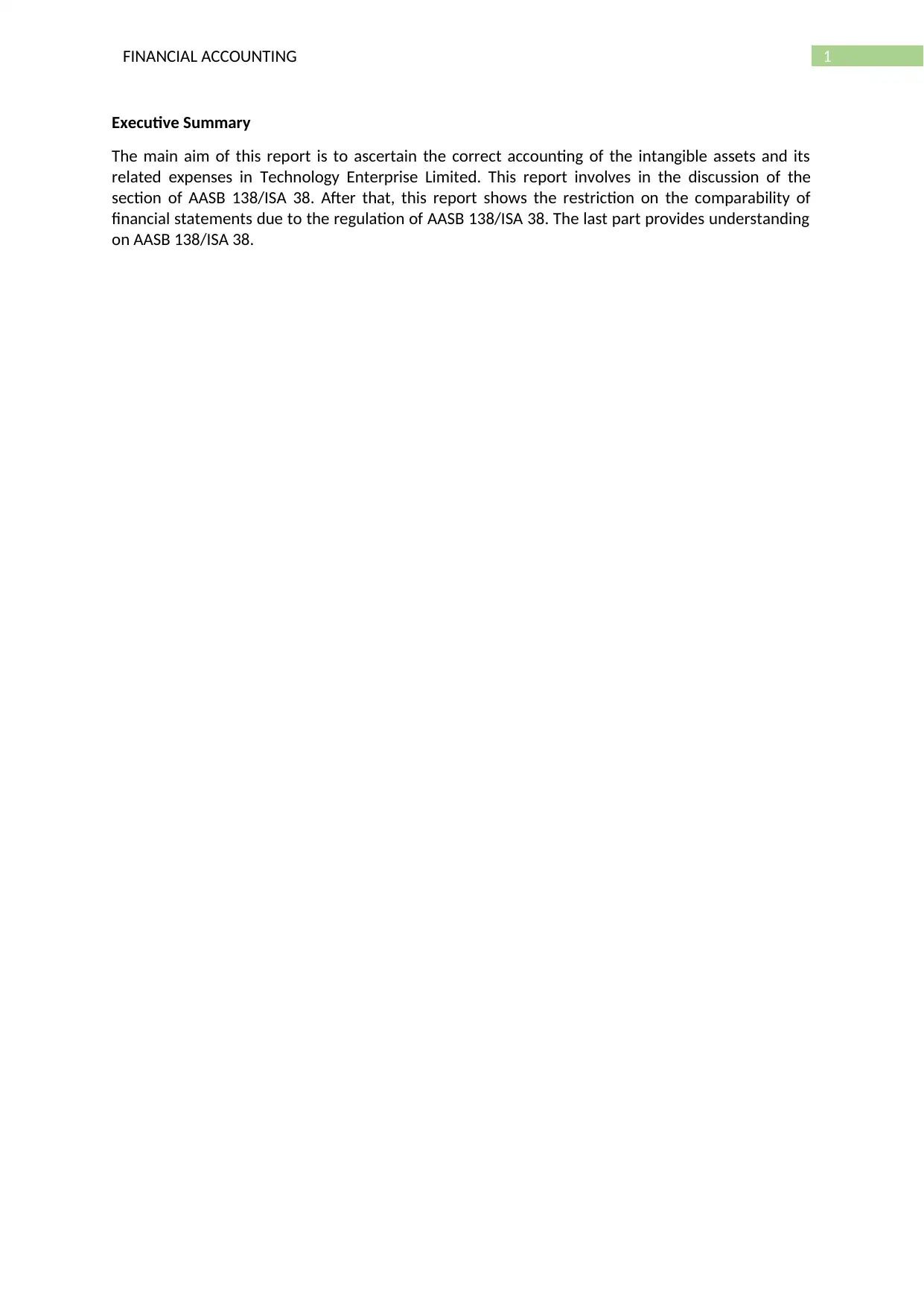
1FINANCIAL ACCOUNTING
Executive Summary
The main aim of this report is to ascertain the correct accounting of the intangible assets and its
related expenses in Technology Enterprise Limited. This report involves in the discussion of the
section of AASB 138/ISA 38. After that, this report shows the restriction on the comparability of
financial statements due to the regulation of AASB 138/ISA 38. The last part provides understanding
on AASB 138/ISA 38.
Executive Summary
The main aim of this report is to ascertain the correct accounting of the intangible assets and its
related expenses in Technology Enterprise Limited. This report involves in the discussion of the
section of AASB 138/ISA 38. After that, this report shows the restriction on the comparability of
financial statements due to the regulation of AASB 138/ISA 38. The last part provides understanding
on AASB 138/ISA 38.
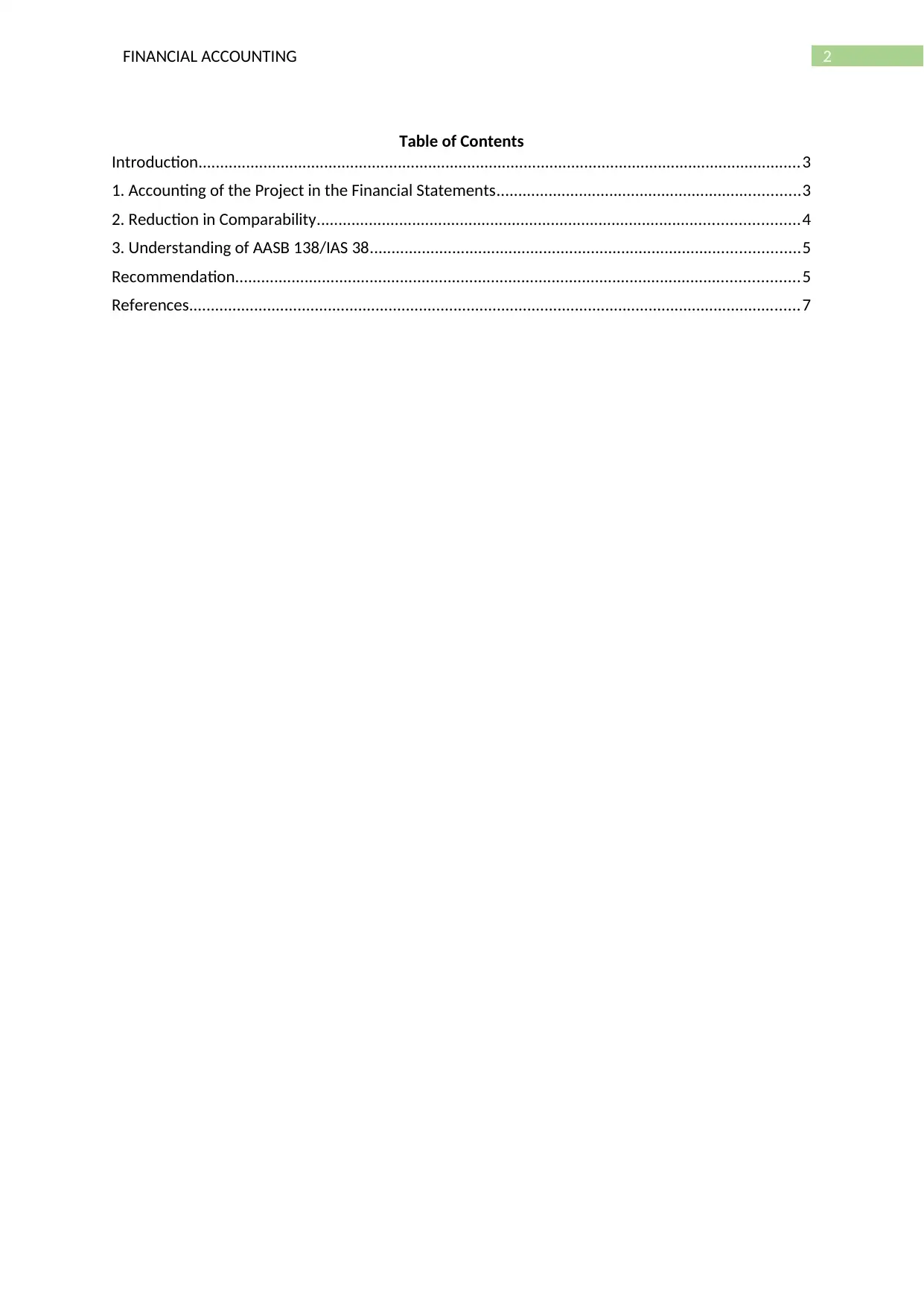
2FINANCIAL ACCOUNTING
Table of Contents
Introduction...........................................................................................................................................3
1. Accounting of the Project in the Financial Statements......................................................................3
2. Reduction in Comparability...............................................................................................................4
3. Understanding of AASB 138/IAS 38...................................................................................................5
Recommendation..................................................................................................................................5
References.............................................................................................................................................7
Table of Contents
Introduction...........................................................................................................................................3
1. Accounting of the Project in the Financial Statements......................................................................3
2. Reduction in Comparability...............................................................................................................4
3. Understanding of AASB 138/IAS 38...................................................................................................5
Recommendation..................................................................................................................................5
References.............................................................................................................................................7
⊘ This is a preview!⊘
Do you want full access?
Subscribe today to unlock all pages.

Trusted by 1+ million students worldwide
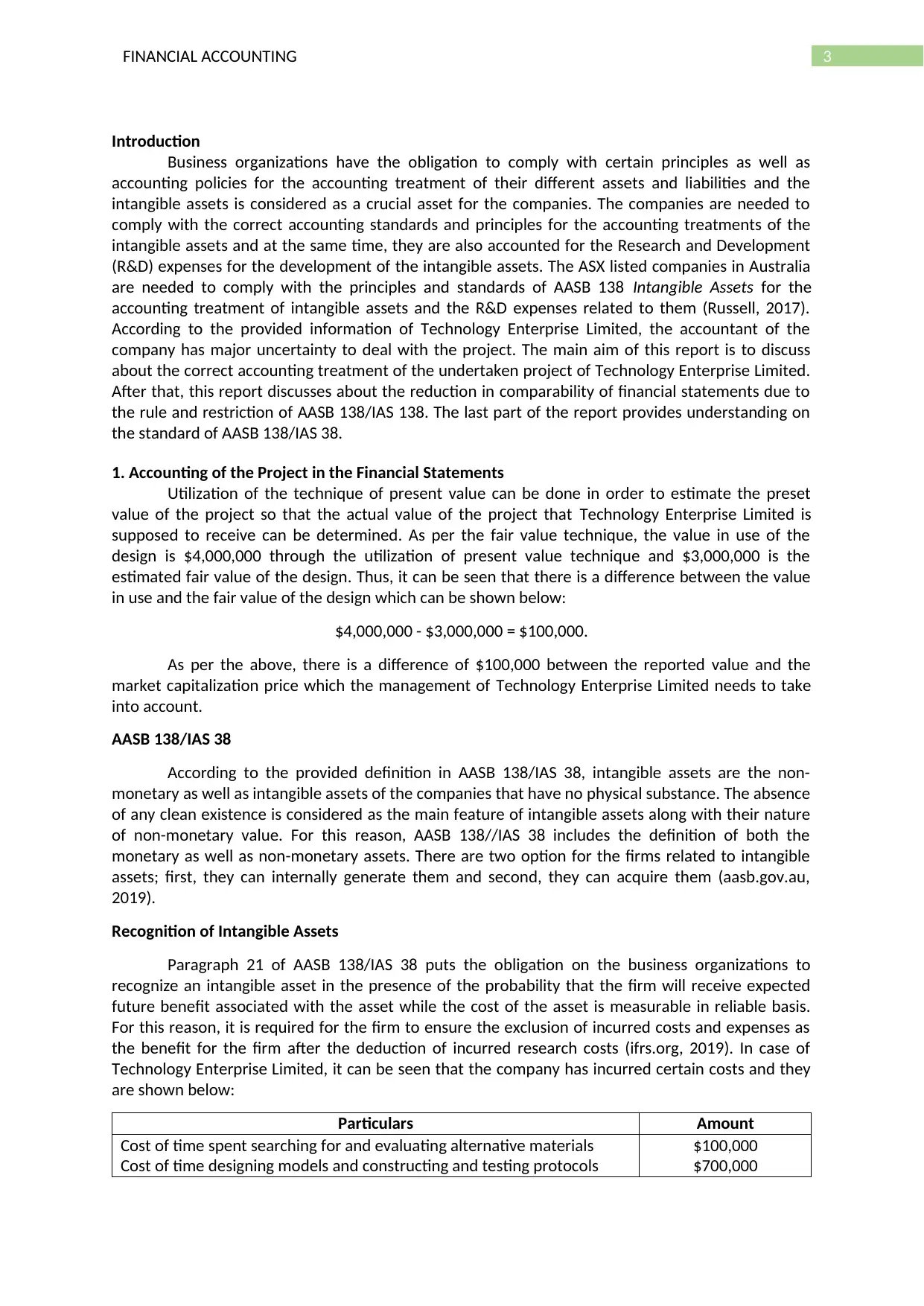
3FINANCIAL ACCOUNTING
Introduction
Business organizations have the obligation to comply with certain principles as well as
accounting policies for the accounting treatment of their different assets and liabilities and the
intangible assets is considered as a crucial asset for the companies. The companies are needed to
comply with the correct accounting standards and principles for the accounting treatments of the
intangible assets and at the same time, they are also accounted for the Research and Development
(R&D) expenses for the development of the intangible assets. The ASX listed companies in Australia
are needed to comply with the principles and standards of AASB 138 Intangible Assets for the
accounting treatment of intangible assets and the R&D expenses related to them (Russell, 2017).
According to the provided information of Technology Enterprise Limited, the accountant of the
company has major uncertainty to deal with the project. The main aim of this report is to discuss
about the correct accounting treatment of the undertaken project of Technology Enterprise Limited.
After that, this report discusses about the reduction in comparability of financial statements due to
the rule and restriction of AASB 138/IAS 138. The last part of the report provides understanding on
the standard of AASB 138/IAS 38.
1. Accounting of the Project in the Financial Statements
Utilization of the technique of present value can be done in order to estimate the preset
value of the project so that the actual value of the project that Technology Enterprise Limited is
supposed to receive can be determined. As per the fair value technique, the value in use of the
design is $4,000,000 through the utilization of present value technique and $3,000,000 is the
estimated fair value of the design. Thus, it can be seen that there is a difference between the value
in use and the fair value of the design which can be shown below:
$4,000,000 - $3,000,000 = $100,000.
As per the above, there is a difference of $100,000 between the reported value and the
market capitalization price which the management of Technology Enterprise Limited needs to take
into account.
AASB 138/IAS 38
According to the provided definition in AASB 138/IAS 38, intangible assets are the non-
monetary as well as intangible assets of the companies that have no physical substance. The absence
of any clean existence is considered as the main feature of intangible assets along with their nature
of non-monetary value. For this reason, AASB 138//IAS 38 includes the definition of both the
monetary as well as non-monetary assets. There are two option for the firms related to intangible
assets; first, they can internally generate them and second, they can acquire them (aasb.gov.au,
2019).
Recognition of Intangible Assets
Paragraph 21 of AASB 138/IAS 38 puts the obligation on the business organizations to
recognize an intangible asset in the presence of the probability that the firm will receive expected
future benefit associated with the asset while the cost of the asset is measurable in reliable basis.
For this reason, it is required for the firm to ensure the exclusion of incurred costs and expenses as
the benefit for the firm after the deduction of incurred research costs (ifrs.org, 2019). In case of
Technology Enterprise Limited, it can be seen that the company has incurred certain costs and they
are shown below:
Particulars Amount
Cost of time spent searching for and evaluating alternative materials
Cost of time designing models and constructing and testing protocols
$100,000
$700,000
Introduction
Business organizations have the obligation to comply with certain principles as well as
accounting policies for the accounting treatment of their different assets and liabilities and the
intangible assets is considered as a crucial asset for the companies. The companies are needed to
comply with the correct accounting standards and principles for the accounting treatments of the
intangible assets and at the same time, they are also accounted for the Research and Development
(R&D) expenses for the development of the intangible assets. The ASX listed companies in Australia
are needed to comply with the principles and standards of AASB 138 Intangible Assets for the
accounting treatment of intangible assets and the R&D expenses related to them (Russell, 2017).
According to the provided information of Technology Enterprise Limited, the accountant of the
company has major uncertainty to deal with the project. The main aim of this report is to discuss
about the correct accounting treatment of the undertaken project of Technology Enterprise Limited.
After that, this report discusses about the reduction in comparability of financial statements due to
the rule and restriction of AASB 138/IAS 138. The last part of the report provides understanding on
the standard of AASB 138/IAS 38.
1. Accounting of the Project in the Financial Statements
Utilization of the technique of present value can be done in order to estimate the preset
value of the project so that the actual value of the project that Technology Enterprise Limited is
supposed to receive can be determined. As per the fair value technique, the value in use of the
design is $4,000,000 through the utilization of present value technique and $3,000,000 is the
estimated fair value of the design. Thus, it can be seen that there is a difference between the value
in use and the fair value of the design which can be shown below:
$4,000,000 - $3,000,000 = $100,000.
As per the above, there is a difference of $100,000 between the reported value and the
market capitalization price which the management of Technology Enterprise Limited needs to take
into account.
AASB 138/IAS 38
According to the provided definition in AASB 138/IAS 38, intangible assets are the non-
monetary as well as intangible assets of the companies that have no physical substance. The absence
of any clean existence is considered as the main feature of intangible assets along with their nature
of non-monetary value. For this reason, AASB 138//IAS 38 includes the definition of both the
monetary as well as non-monetary assets. There are two option for the firms related to intangible
assets; first, they can internally generate them and second, they can acquire them (aasb.gov.au,
2019).
Recognition of Intangible Assets
Paragraph 21 of AASB 138/IAS 38 puts the obligation on the business organizations to
recognize an intangible asset in the presence of the probability that the firm will receive expected
future benefit associated with the asset while the cost of the asset is measurable in reliable basis.
For this reason, it is required for the firm to ensure the exclusion of incurred costs and expenses as
the benefit for the firm after the deduction of incurred research costs (ifrs.org, 2019). In case of
Technology Enterprise Limited, it can be seen that the company has incurred certain costs and they
are shown below:
Particulars Amount
Cost of time spent searching for and evaluating alternative materials
Cost of time designing models and constructing and testing protocols
$100,000
$700,000
Paraphrase This Document
Need a fresh take? Get an instant paraphrase of this document with our AI Paraphraser
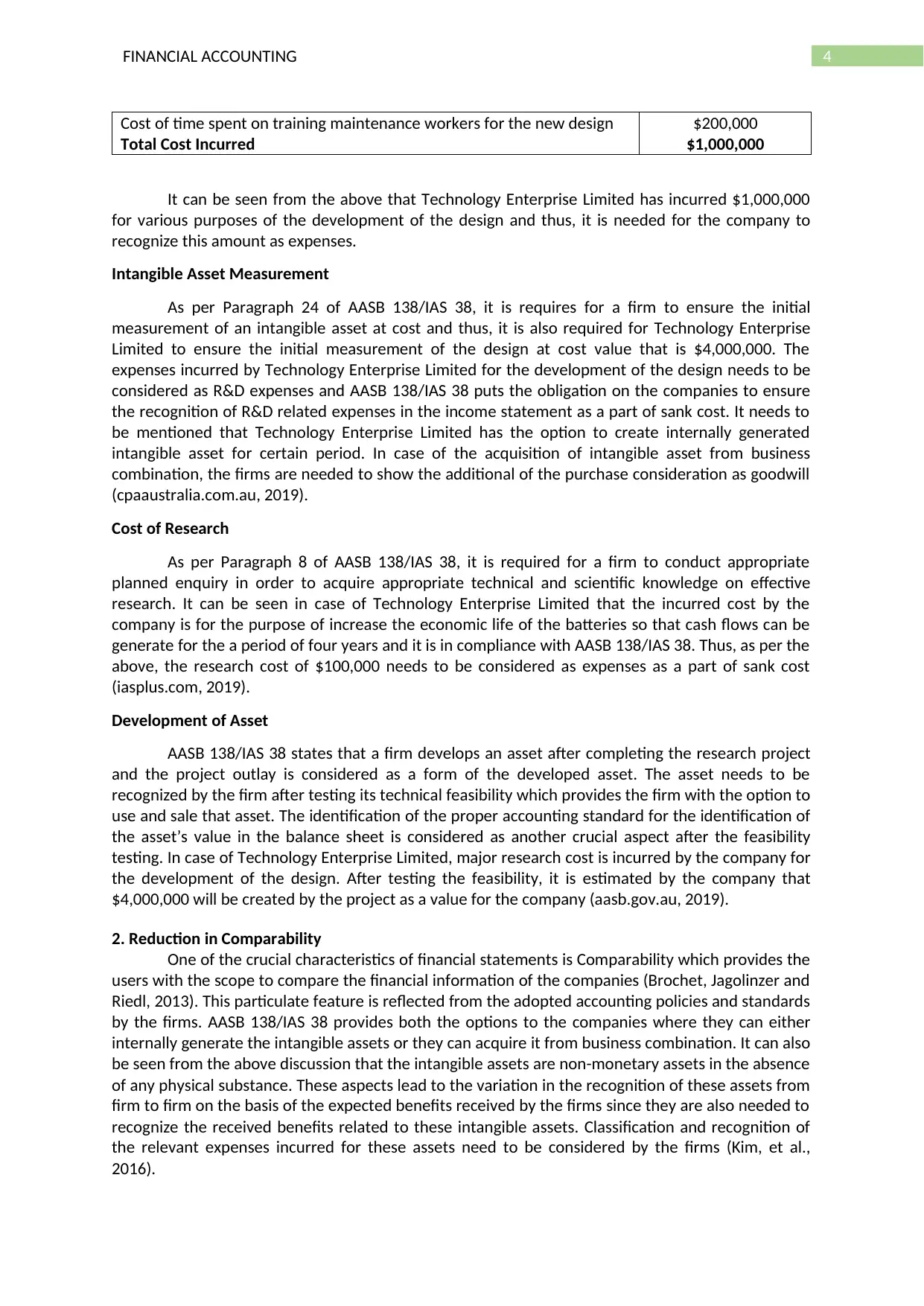
4FINANCIAL ACCOUNTING
Cost of time spent on training maintenance workers for the new design
Total Cost Incurred
$200,000
$1,000,000
It can be seen from the above that Technology Enterprise Limited has incurred $1,000,000
for various purposes of the development of the design and thus, it is needed for the company to
recognize this amount as expenses.
Intangible Asset Measurement
As per Paragraph 24 of AASB 138/IAS 38, it is requires for a firm to ensure the initial
measurement of an intangible asset at cost and thus, it is also required for Technology Enterprise
Limited to ensure the initial measurement of the design at cost value that is $4,000,000. The
expenses incurred by Technology Enterprise Limited for the development of the design needs to be
considered as R&D expenses and AASB 138/IAS 38 puts the obligation on the companies to ensure
the recognition of R&D related expenses in the income statement as a part of sank cost. It needs to
be mentioned that Technology Enterprise Limited has the option to create internally generated
intangible asset for certain period. In case of the acquisition of intangible asset from business
combination, the firms are needed to show the additional of the purchase consideration as goodwill
(cpaaustralia.com.au, 2019).
Cost of Research
As per Paragraph 8 of AASB 138/IAS 38, it is required for a firm to conduct appropriate
planned enquiry in order to acquire appropriate technical and scientific knowledge on effective
research. It can be seen in case of Technology Enterprise Limited that the incurred cost by the
company is for the purpose of increase the economic life of the batteries so that cash flows can be
generate for the a period of four years and it is in compliance with AASB 138/IAS 38. Thus, as per the
above, the research cost of $100,000 needs to be considered as expenses as a part of sank cost
(iasplus.com, 2019).
Development of Asset
AASB 138/IAS 38 states that a firm develops an asset after completing the research project
and the project outlay is considered as a form of the developed asset. The asset needs to be
recognized by the firm after testing its technical feasibility which provides the firm with the option to
use and sale that asset. The identification of the proper accounting standard for the identification of
the asset’s value in the balance sheet is considered as another crucial aspect after the feasibility
testing. In case of Technology Enterprise Limited, major research cost is incurred by the company for
the development of the design. After testing the feasibility, it is estimated by the company that
$4,000,000 will be created by the project as a value for the company (aasb.gov.au, 2019).
2. Reduction in Comparability
One of the crucial characteristics of financial statements is Comparability which provides the
users with the scope to compare the financial information of the companies (Brochet, Jagolinzer and
Riedl, 2013). This particulate feature is reflected from the adopted accounting policies and standards
by the firms. AASB 138/IAS 38 provides both the options to the companies where they can either
internally generate the intangible assets or they can acquire it from business combination. It can also
be seen from the above discussion that the intangible assets are non-monetary assets in the absence
of any physical substance. These aspects lead to the variation in the recognition of these assets from
firm to firm on the basis of the expected benefits received by the firms since they are also needed to
recognize the received benefits related to these intangible assets. Classification and recognition of
the relevant expenses incurred for these assets need to be considered by the firms (Kim, et al.,
2016).
Cost of time spent on training maintenance workers for the new design
Total Cost Incurred
$200,000
$1,000,000
It can be seen from the above that Technology Enterprise Limited has incurred $1,000,000
for various purposes of the development of the design and thus, it is needed for the company to
recognize this amount as expenses.
Intangible Asset Measurement
As per Paragraph 24 of AASB 138/IAS 38, it is requires for a firm to ensure the initial
measurement of an intangible asset at cost and thus, it is also required for Technology Enterprise
Limited to ensure the initial measurement of the design at cost value that is $4,000,000. The
expenses incurred by Technology Enterprise Limited for the development of the design needs to be
considered as R&D expenses and AASB 138/IAS 38 puts the obligation on the companies to ensure
the recognition of R&D related expenses in the income statement as a part of sank cost. It needs to
be mentioned that Technology Enterprise Limited has the option to create internally generated
intangible asset for certain period. In case of the acquisition of intangible asset from business
combination, the firms are needed to show the additional of the purchase consideration as goodwill
(cpaaustralia.com.au, 2019).
Cost of Research
As per Paragraph 8 of AASB 138/IAS 38, it is required for a firm to conduct appropriate
planned enquiry in order to acquire appropriate technical and scientific knowledge on effective
research. It can be seen in case of Technology Enterprise Limited that the incurred cost by the
company is for the purpose of increase the economic life of the batteries so that cash flows can be
generate for the a period of four years and it is in compliance with AASB 138/IAS 38. Thus, as per the
above, the research cost of $100,000 needs to be considered as expenses as a part of sank cost
(iasplus.com, 2019).
Development of Asset
AASB 138/IAS 38 states that a firm develops an asset after completing the research project
and the project outlay is considered as a form of the developed asset. The asset needs to be
recognized by the firm after testing its technical feasibility which provides the firm with the option to
use and sale that asset. The identification of the proper accounting standard for the identification of
the asset’s value in the balance sheet is considered as another crucial aspect after the feasibility
testing. In case of Technology Enterprise Limited, major research cost is incurred by the company for
the development of the design. After testing the feasibility, it is estimated by the company that
$4,000,000 will be created by the project as a value for the company (aasb.gov.au, 2019).
2. Reduction in Comparability
One of the crucial characteristics of financial statements is Comparability which provides the
users with the scope to compare the financial information of the companies (Brochet, Jagolinzer and
Riedl, 2013). This particulate feature is reflected from the adopted accounting policies and standards
by the firms. AASB 138/IAS 38 provides both the options to the companies where they can either
internally generate the intangible assets or they can acquire it from business combination. It can also
be seen from the above discussion that the intangible assets are non-monetary assets in the absence
of any physical substance. These aspects lead to the variation in the recognition of these assets from
firm to firm on the basis of the expected benefits received by the firms since they are also needed to
recognize the received benefits related to these intangible assets. Classification and recognition of
the relevant expenses incurred for these assets need to be considered by the firms (Kim, et al.,
2016).
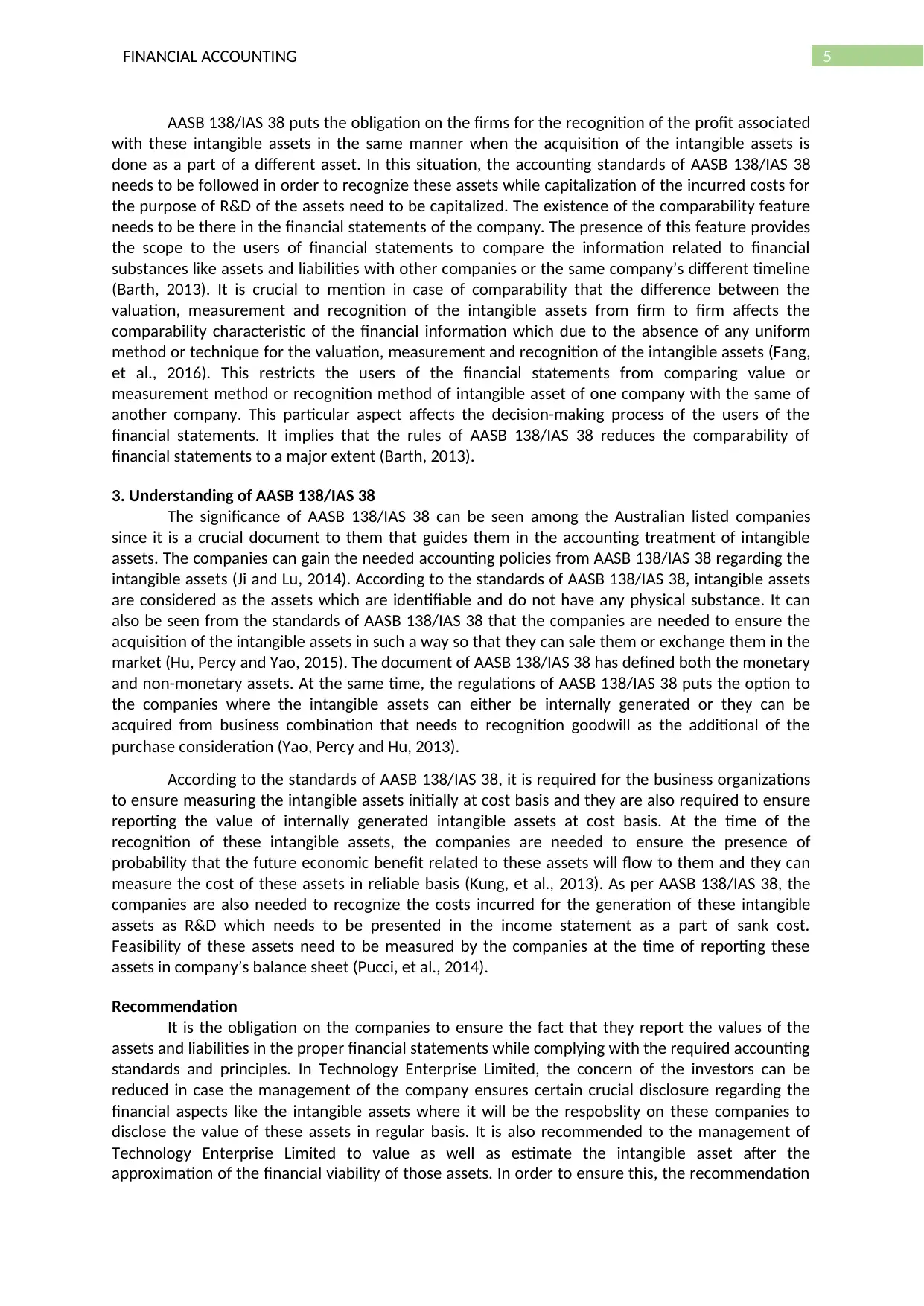
5FINANCIAL ACCOUNTING
AASB 138/IAS 38 puts the obligation on the firms for the recognition of the profit associated
with these intangible assets in the same manner when the acquisition of the intangible assets is
done as a part of a different asset. In this situation, the accounting standards of AASB 138/IAS 38
needs to be followed in order to recognize these assets while capitalization of the incurred costs for
the purpose of R&D of the assets need to be capitalized. The existence of the comparability feature
needs to be there in the financial statements of the company. The presence of this feature provides
the scope to the users of financial statements to compare the information related to financial
substances like assets and liabilities with other companies or the same company’s different timeline
(Barth, 2013). It is crucial to mention in case of comparability that the difference between the
valuation, measurement and recognition of the intangible assets from firm to firm affects the
comparability characteristic of the financial information which due to the absence of any uniform
method or technique for the valuation, measurement and recognition of the intangible assets (Fang,
et al., 2016). This restricts the users of the financial statements from comparing value or
measurement method or recognition method of intangible asset of one company with the same of
another company. This particular aspect affects the decision-making process of the users of the
financial statements. It implies that the rules of AASB 138/IAS 38 reduces the comparability of
financial statements to a major extent (Barth, 2013).
3. Understanding of AASB 138/IAS 38
The significance of AASB 138/IAS 38 can be seen among the Australian listed companies
since it is a crucial document to them that guides them in the accounting treatment of intangible
assets. The companies can gain the needed accounting policies from AASB 138/IAS 38 regarding the
intangible assets (Ji and Lu, 2014). According to the standards of AASB 138/IAS 38, intangible assets
are considered as the assets which are identifiable and do not have any physical substance. It can
also be seen from the standards of AASB 138/IAS 38 that the companies are needed to ensure the
acquisition of the intangible assets in such a way so that they can sale them or exchange them in the
market (Hu, Percy and Yao, 2015). The document of AASB 138/IAS 38 has defined both the monetary
and non-monetary assets. At the same time, the regulations of AASB 138/IAS 38 puts the option to
the companies where the intangible assets can either be internally generated or they can be
acquired from business combination that needs to recognition goodwill as the additional of the
purchase consideration (Yao, Percy and Hu, 2013).
According to the standards of AASB 138/IAS 38, it is required for the business organizations
to ensure measuring the intangible assets initially at cost basis and they are also required to ensure
reporting the value of internally generated intangible assets at cost basis. At the time of the
recognition of these intangible assets, the companies are needed to ensure the presence of
probability that the future economic benefit related to these assets will flow to them and they can
measure the cost of these assets in reliable basis (Kung, et al., 2013). As per AASB 138/IAS 38, the
companies are also needed to recognize the costs incurred for the generation of these intangible
assets as R&D which needs to be presented in the income statement as a part of sank cost.
Feasibility of these assets need to be measured by the companies at the time of reporting these
assets in company’s balance sheet (Pucci, et al., 2014).
Recommendation
It is the obligation on the companies to ensure the fact that they report the values of the
assets and liabilities in the proper financial statements while complying with the required accounting
standards and principles. In Technology Enterprise Limited, the concern of the investors can be
reduced in case the management of the company ensures certain crucial disclosure regarding the
financial aspects like the intangible assets where it will be the respobslity on these companies to
disclose the value of these assets in regular basis. It is also recommended to the management of
Technology Enterprise Limited to value as well as estimate the intangible asset after the
approximation of the financial viability of those assets. In order to ensure this, the recommendation
AASB 138/IAS 38 puts the obligation on the firms for the recognition of the profit associated
with these intangible assets in the same manner when the acquisition of the intangible assets is
done as a part of a different asset. In this situation, the accounting standards of AASB 138/IAS 38
needs to be followed in order to recognize these assets while capitalization of the incurred costs for
the purpose of R&D of the assets need to be capitalized. The existence of the comparability feature
needs to be there in the financial statements of the company. The presence of this feature provides
the scope to the users of financial statements to compare the information related to financial
substances like assets and liabilities with other companies or the same company’s different timeline
(Barth, 2013). It is crucial to mention in case of comparability that the difference between the
valuation, measurement and recognition of the intangible assets from firm to firm affects the
comparability characteristic of the financial information which due to the absence of any uniform
method or technique for the valuation, measurement and recognition of the intangible assets (Fang,
et al., 2016). This restricts the users of the financial statements from comparing value or
measurement method or recognition method of intangible asset of one company with the same of
another company. This particular aspect affects the decision-making process of the users of the
financial statements. It implies that the rules of AASB 138/IAS 38 reduces the comparability of
financial statements to a major extent (Barth, 2013).
3. Understanding of AASB 138/IAS 38
The significance of AASB 138/IAS 38 can be seen among the Australian listed companies
since it is a crucial document to them that guides them in the accounting treatment of intangible
assets. The companies can gain the needed accounting policies from AASB 138/IAS 38 regarding the
intangible assets (Ji and Lu, 2014). According to the standards of AASB 138/IAS 38, intangible assets
are considered as the assets which are identifiable and do not have any physical substance. It can
also be seen from the standards of AASB 138/IAS 38 that the companies are needed to ensure the
acquisition of the intangible assets in such a way so that they can sale them or exchange them in the
market (Hu, Percy and Yao, 2015). The document of AASB 138/IAS 38 has defined both the monetary
and non-monetary assets. At the same time, the regulations of AASB 138/IAS 38 puts the option to
the companies where the intangible assets can either be internally generated or they can be
acquired from business combination that needs to recognition goodwill as the additional of the
purchase consideration (Yao, Percy and Hu, 2013).
According to the standards of AASB 138/IAS 38, it is required for the business organizations
to ensure measuring the intangible assets initially at cost basis and they are also required to ensure
reporting the value of internally generated intangible assets at cost basis. At the time of the
recognition of these intangible assets, the companies are needed to ensure the presence of
probability that the future economic benefit related to these assets will flow to them and they can
measure the cost of these assets in reliable basis (Kung, et al., 2013). As per AASB 138/IAS 38, the
companies are also needed to recognize the costs incurred for the generation of these intangible
assets as R&D which needs to be presented in the income statement as a part of sank cost.
Feasibility of these assets need to be measured by the companies at the time of reporting these
assets in company’s balance sheet (Pucci, et al., 2014).
Recommendation
It is the obligation on the companies to ensure the fact that they report the values of the
assets and liabilities in the proper financial statements while complying with the required accounting
standards and principles. In Technology Enterprise Limited, the concern of the investors can be
reduced in case the management of the company ensures certain crucial disclosure regarding the
financial aspects like the intangible assets where it will be the respobslity on these companies to
disclose the value of these assets in regular basis. It is also recommended to the management of
Technology Enterprise Limited to value as well as estimate the intangible asset after the
approximation of the financial viability of those assets. In order to ensure this, the recommendation
⊘ This is a preview!⊘
Do you want full access?
Subscribe today to unlock all pages.

Trusted by 1+ million students worldwide
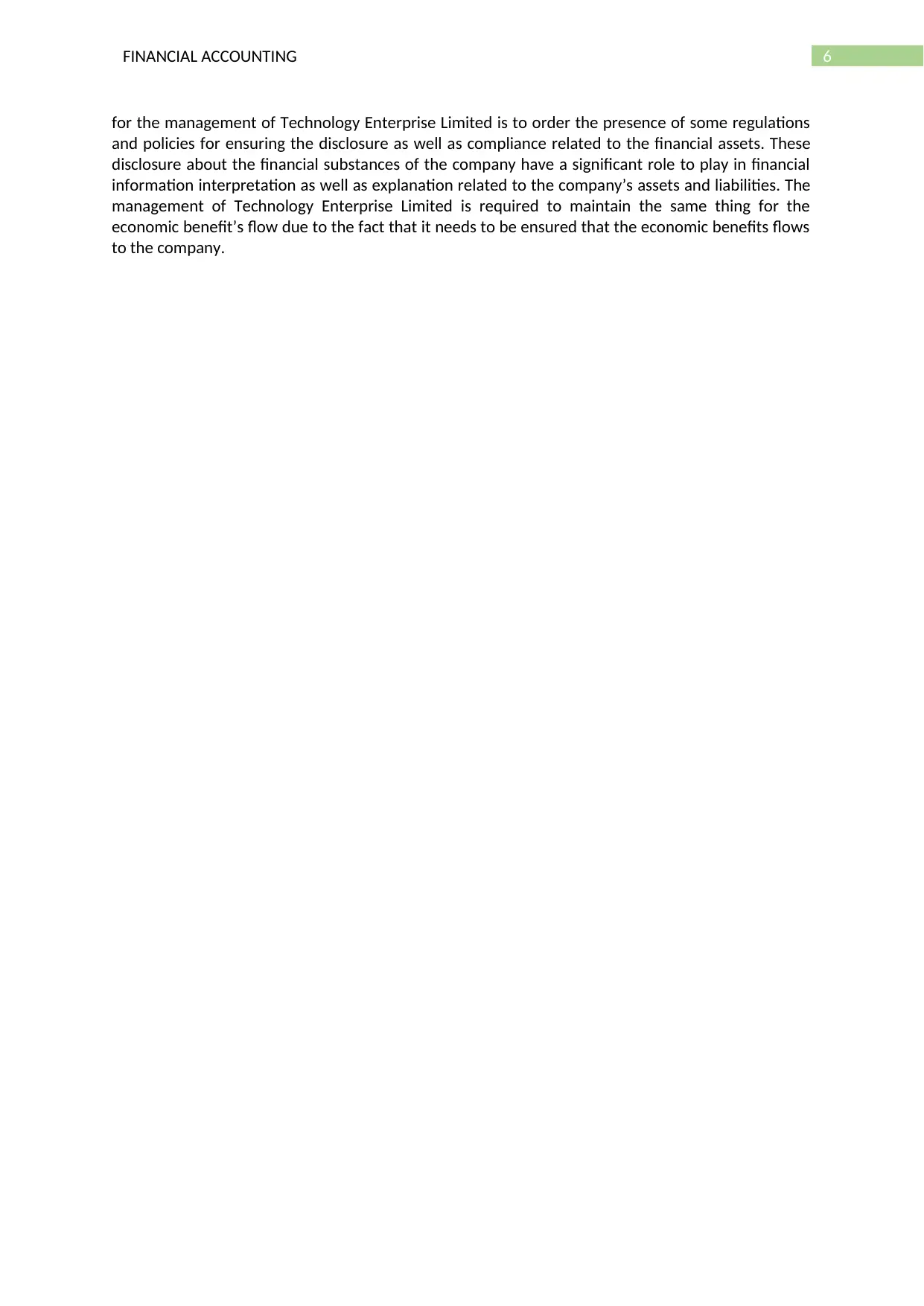
6FINANCIAL ACCOUNTING
for the management of Technology Enterprise Limited is to order the presence of some regulations
and policies for ensuring the disclosure as well as compliance related to the financial assets. These
disclosure about the financial substances of the company have a significant role to play in financial
information interpretation as well as explanation related to the company’s assets and liabilities. The
management of Technology Enterprise Limited is required to maintain the same thing for the
economic benefit’s flow due to the fact that it needs to be ensured that the economic benefits flows
to the company.
for the management of Technology Enterprise Limited is to order the presence of some regulations
and policies for ensuring the disclosure as well as compliance related to the financial assets. These
disclosure about the financial substances of the company have a significant role to play in financial
information interpretation as well as explanation related to the company’s assets and liabilities. The
management of Technology Enterprise Limited is required to maintain the same thing for the
economic benefit’s flow due to the fact that it needs to be ensured that the economic benefits flows
to the company.
Paraphrase This Document
Need a fresh take? Get an instant paraphrase of this document with our AI Paraphraser
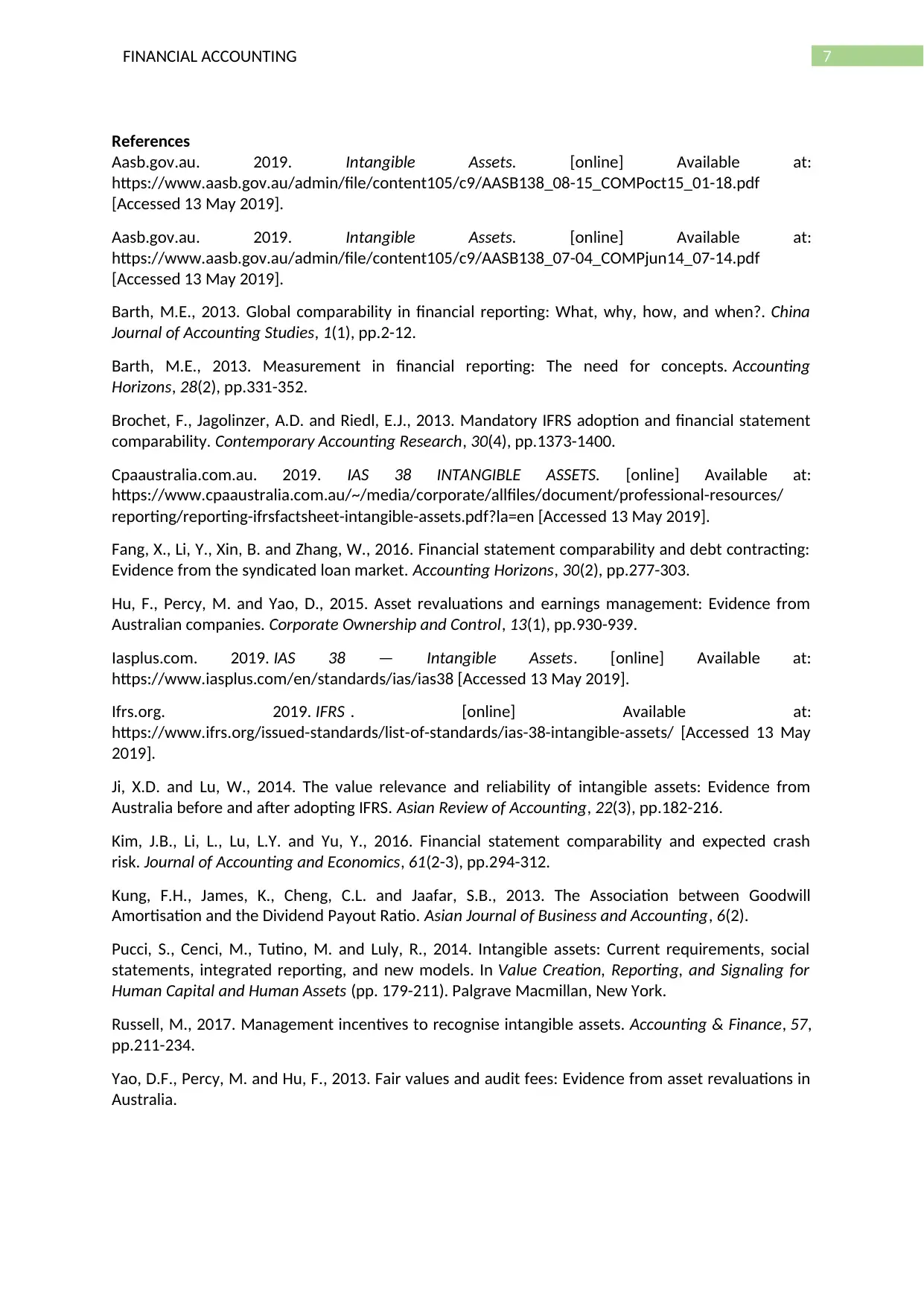
7FINANCIAL ACCOUNTING
References
Aasb.gov.au. 2019. Intangible Assets. [online] Available at:
https://www.aasb.gov.au/admin/file/content105/c9/AASB138_08-15_COMPoct15_01-18.pdf
[Accessed 13 May 2019].
Aasb.gov.au. 2019. Intangible Assets. [online] Available at:
https://www.aasb.gov.au/admin/file/content105/c9/AASB138_07-04_COMPjun14_07-14.pdf
[Accessed 13 May 2019].
Barth, M.E., 2013. Global comparability in financial reporting: What, why, how, and when?. China
Journal of Accounting Studies, 1(1), pp.2-12.
Barth, M.E., 2013. Measurement in financial reporting: The need for concepts. Accounting
Horizons, 28(2), pp.331-352.
Brochet, F., Jagolinzer, A.D. and Riedl, E.J., 2013. Mandatory IFRS adoption and financial statement
comparability. Contemporary Accounting Research, 30(4), pp.1373-1400.
Cpaaustralia.com.au. 2019. IAS 38 INTANGIBLE ASSETS. [online] Available at:
https://www.cpaaustralia.com.au/~/media/corporate/allfiles/document/professional-resources/
reporting/reporting-ifrsfactsheet-intangible-assets.pdf?la=en [Accessed 13 May 2019].
Fang, X., Li, Y., Xin, B. and Zhang, W., 2016. Financial statement comparability and debt contracting:
Evidence from the syndicated loan market. Accounting Horizons, 30(2), pp.277-303.
Hu, F., Percy, M. and Yao, D., 2015. Asset revaluations and earnings management: Evidence from
Australian companies. Corporate Ownership and Control, 13(1), pp.930-939.
Iasplus.com. 2019. IAS 38 — Intangible Assets. [online] Available at:
https://www.iasplus.com/en/standards/ias/ias38 [Accessed 13 May 2019].
Ifrs.org. 2019. IFRS . [online] Available at:
https://www.ifrs.org/issued-standards/list-of-standards/ias-38-intangible-assets/ [Accessed 13 May
2019].
Ji, X.D. and Lu, W., 2014. The value relevance and reliability of intangible assets: Evidence from
Australia before and after adopting IFRS. Asian Review of Accounting, 22(3), pp.182-216.
Kim, J.B., Li, L., Lu, L.Y. and Yu, Y., 2016. Financial statement comparability and expected crash
risk. Journal of Accounting and Economics, 61(2-3), pp.294-312.
Kung, F.H., James, K., Cheng, C.L. and Jaafar, S.B., 2013. The Association between Goodwill
Amortisation and the Dividend Payout Ratio. Asian Journal of Business and Accounting, 6(2).
Pucci, S., Cenci, M., Tutino, M. and Luly, R., 2014. Intangible assets: Current requirements, social
statements, integrated reporting, and new models. In Value Creation, Reporting, and Signaling for
Human Capital and Human Assets (pp. 179-211). Palgrave Macmillan, New York.
Russell, M., 2017. Management incentives to recognise intangible assets. Accounting & Finance, 57,
pp.211-234.
Yao, D.F., Percy, M. and Hu, F., 2013. Fair values and audit fees: Evidence from asset revaluations in
Australia.
References
Aasb.gov.au. 2019. Intangible Assets. [online] Available at:
https://www.aasb.gov.au/admin/file/content105/c9/AASB138_08-15_COMPoct15_01-18.pdf
[Accessed 13 May 2019].
Aasb.gov.au. 2019. Intangible Assets. [online] Available at:
https://www.aasb.gov.au/admin/file/content105/c9/AASB138_07-04_COMPjun14_07-14.pdf
[Accessed 13 May 2019].
Barth, M.E., 2013. Global comparability in financial reporting: What, why, how, and when?. China
Journal of Accounting Studies, 1(1), pp.2-12.
Barth, M.E., 2013. Measurement in financial reporting: The need for concepts. Accounting
Horizons, 28(2), pp.331-352.
Brochet, F., Jagolinzer, A.D. and Riedl, E.J., 2013. Mandatory IFRS adoption and financial statement
comparability. Contemporary Accounting Research, 30(4), pp.1373-1400.
Cpaaustralia.com.au. 2019. IAS 38 INTANGIBLE ASSETS. [online] Available at:
https://www.cpaaustralia.com.au/~/media/corporate/allfiles/document/professional-resources/
reporting/reporting-ifrsfactsheet-intangible-assets.pdf?la=en [Accessed 13 May 2019].
Fang, X., Li, Y., Xin, B. and Zhang, W., 2016. Financial statement comparability and debt contracting:
Evidence from the syndicated loan market. Accounting Horizons, 30(2), pp.277-303.
Hu, F., Percy, M. and Yao, D., 2015. Asset revaluations and earnings management: Evidence from
Australian companies. Corporate Ownership and Control, 13(1), pp.930-939.
Iasplus.com. 2019. IAS 38 — Intangible Assets. [online] Available at:
https://www.iasplus.com/en/standards/ias/ias38 [Accessed 13 May 2019].
Ifrs.org. 2019. IFRS . [online] Available at:
https://www.ifrs.org/issued-standards/list-of-standards/ias-38-intangible-assets/ [Accessed 13 May
2019].
Ji, X.D. and Lu, W., 2014. The value relevance and reliability of intangible assets: Evidence from
Australia before and after adopting IFRS. Asian Review of Accounting, 22(3), pp.182-216.
Kim, J.B., Li, L., Lu, L.Y. and Yu, Y., 2016. Financial statement comparability and expected crash
risk. Journal of Accounting and Economics, 61(2-3), pp.294-312.
Kung, F.H., James, K., Cheng, C.L. and Jaafar, S.B., 2013. The Association between Goodwill
Amortisation and the Dividend Payout Ratio. Asian Journal of Business and Accounting, 6(2).
Pucci, S., Cenci, M., Tutino, M. and Luly, R., 2014. Intangible assets: Current requirements, social
statements, integrated reporting, and new models. In Value Creation, Reporting, and Signaling for
Human Capital and Human Assets (pp. 179-211). Palgrave Macmillan, New York.
Russell, M., 2017. Management incentives to recognise intangible assets. Accounting & Finance, 57,
pp.211-234.
Yao, D.F., Percy, M. and Hu, F., 2013. Fair values and audit fees: Evidence from asset revaluations in
Australia.
1 out of 8
Related Documents
Your All-in-One AI-Powered Toolkit for Academic Success.
+13062052269
info@desklib.com
Available 24*7 on WhatsApp / Email
![[object Object]](/_next/static/media/star-bottom.7253800d.svg)
Unlock your academic potential
Copyright © 2020–2025 A2Z Services. All Rights Reserved. Developed and managed by ZUCOL.





